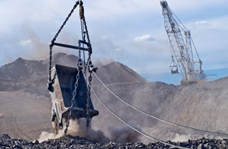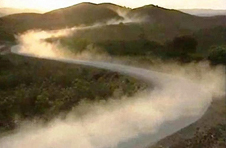For Box Elder, Cache, Davis, Salt Lake, Tooele, Utah, and Weber Counties

Fugitive dust is particles of soil, ash, coal, minerals, etc., which becomes airborne because of wind or mechanical disturbance. Fugitive dust can be generated from natural causes such as wind or from manmade causes such as unpaved haul roads and operational areas, storage, hauling and handling of aggregate materials, construction activities and demolition activities. Fugitive dust contributes particulate matter (PM) emissions to the atmosphere. PM emissions must be minimized in order to meet National Ambient Air Quality Standards (NAAQS). The regulations described herein are for the following areas of the state:
- all regions of Salt Lake and Davis counties
- all portions of the Cache Valley
- all regions in Weber and Utah counties west of the Wasatch mountain range
- in Box Elder County, from the Wasatch mountain range west to the Promontory mountain range and south of Portage
- in Tooele County, from the northernmost part of the Oquirrh mountain range to the northern most part of the Stansbury mountain range and north of Route 199.
All areas in the state not listed above are regulated by the statewide fugitive dust rules.
Visible Emissions
Fugitive dust is limited to an opacity of 20% or less on site, and 10% or less at the property boundary. Opacity is a measurement of how much visibility is obscured by a plume of dust. For example, if a plume of dust obscures 20% of the view in the background, the visible emissions from the dust plume is 20% opacity.
Visit the EPA Website for more information on how visible emissions are measured.
Fugitive Dust Control Plans
In addition to opacity limits, any source 1/4 acre or greater in size is required to submit a Fugitive Dust Control Plan (FDCP) to the Utah Division of Air Quality (UDAQ). The FDCP is required to help sources minimize the amount of fugitive dust generated onsite.
A source is required to submit a FDCP prior to initial construction or operation and prior to any modifications made on site that effect fugitive dust emissions. The FDCP can be completed online. Plans are no cost and include instant approval for your project.
If completing the FDCP online is not an option, a hard copy may be completed and submitted by mail to the DAQ for electronic processing. To request a hard copy of the fugitive dust rules and form, contact DAQ by phone at (801) 536-4000. Please note: it may take up to 14 days from the date of the request to receive this information or to receive an acceptance letter if a hard copy is submitted for processing.
Fugitive Dust Requirements see R307-309 for Specific Details
Opacity Limits
20% or less on site, and 10% at property boundary.
Fugitive Dust Control Plan
Yes, if site is greater than 1/4 acre in size or demolition activities.
Roadways

- Any person whose activities result in fugitive dust from a road shall minimize fugitive dust to the maximum extent possible.
- Any person who deposits materials that may create fugitive dust on a public or private paved road shall clean the road promptly.
- Any person responsible for construction or maintenance of any existing road or having a right-of-way easement or possessing the right to use a road shall minimize fugitive dust to the maximum extent possible.
- Any person responsible for construction or maintenance of any new or existing unpaved road shall prevent, to the maximum extent possible, the deposit of material from the unpaved road onto any intersecting paved road during construction or maintenance. This includes site entrances and exits for vehicles.
- Demolition activities including razing homes, buildings, or other structures.
Record Keeping
Sources are required to maintain records indicating compliance with the conditions of a FDCP. For high wind events (winds over 25 miles per hour) additional records are required. These records shall be available for review by the UDAQ upon request.
Contact Information
To contact the Division of Air Quality with questions or complaints, call (801) 536-4000, or visit the following Websites for more information:
- Environmental Quality Permits
Access to the online Fugitive Dust Plan Permit Application. - Fugitive Dust Control Plans: Instructions
Information and instructions on completing a of the FDCP. - Utah Administrative Code
Fugitive dust regulations applicable to areas of the state not included in this document. - Utah Division of Administrative Rules
Fugitive dust regulations described in this document. - Utah Division of Air Quality
General air quality information, regulations, and contact information.
